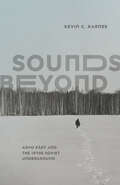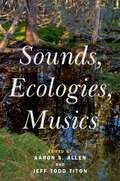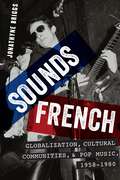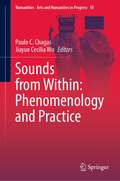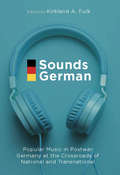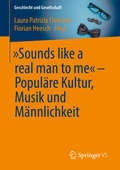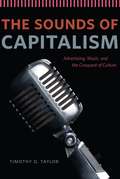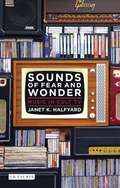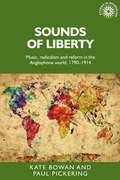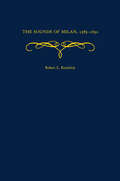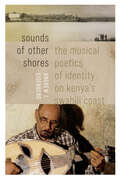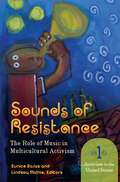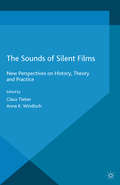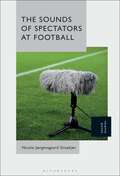- Table View
- List View
Sounds Beyond: Arvo Pärt and the 1970s Soviet Underground
by Kevin C. KarnesSounds Beyond charts the origins of Arvo Pärt’s most famous music, which was created in dialogue with underground creative circles in the USSR. In Sounds Beyond, Kevin C. Karnes studies the interconnected alternative music and art scenes in the USSR during the second half of the 1970s, revealing the audacious origins of some of Estonian composer Arvo Pärt’s most famous music. Karnes shows how Pärt’s work was created within a vital yet forgotten culture of collective experimentation, the Soviet underground. Mining archives and oral history from across the former USSR, Sounds Beyond carefully situates modes of creative experimentation within their late socialist contexts. In documenting Pärt’s work, Karnes reveals the rich creative culture that thrived covertly in the USSR and the network of figures that made underground performances possible: students, audio engineers, sympathetic administrators, star performers, and aspiring DJs. Sounds Beyond advances a new understanding of Pärt’s music as an expression of the aesthetic and religious commitments shared, nurtured, and celebrated by many in Soviet underground circles. At the same time, this story attests to the lasting power of Pärt’s music. Dislodging the mythology of the solitary creative genius, Karnes shows that Pärt’s work would be impossible without community.
Sounds Beyond: Arvo Pärt and the 1970s Soviet Underground
by Kevin C. KarnesSounds Beyond charts the origins of Arvo Pärt’s most famous music, which was created in dialogue with underground creative circles in the USSR. In Sounds Beyond, Kevin C. Karnes studies the interconnected alternative music and art scenes in the USSR during the second half of the 1970s, revealing the audacious origins of some of Estonian composer Arvo Pärt’s most famous music. Karnes shows how Pärt’s work was created within a vital yet forgotten culture of collective experimentation, the Soviet underground. Mining archives and oral history from across the former USSR, Sounds Beyond carefully situates modes of creative experimentation within their late socialist contexts. In documenting Pärt’s work, Karnes reveals the rich creative culture that thrived covertly in the USSR and the network of figures that made underground performances possible: students, audio engineers, sympathetic administrators, star performers, and aspiring DJs. Sounds Beyond advances a new understanding of Pärt’s music as an expression of the aesthetic and religious commitments shared, nurtured, and celebrated by many in Soviet underground circles. At the same time, this story attests to the lasting power of Pärt’s music. Dislodging the mythology of the solitary creative genius, Karnes shows that Pärt’s work would be impossible without community.
Sounds, Ecologies, Musics
by Aaron S. Allen and Jeff Todd TitonSounds, Ecologies, Musics poses exciting challenges and provides fresh opportunities for scholars, scientists, environmental activists, musicians, and listeners to consider music and sound from ecological standpoints. Authors in Part I examine the natural and built environment and how music and sound are woven into it, how the environment enables music and sound, and how the natural and cultural production of music and sound in turn impact the environment. In Part II, contributors consider music and sound in relation to ecological knowledges that appear to conflict with, yet may be viewed as complementary to, Western science: traditional and Indigenous ecological and environmental knowledges. Part III features multidisciplinary and interdisciplinary approaches by scholars, scientists, and practitioners who probe the ecological imaginary regarding the complex ideas and contested keywords that characterize ecomusicology: sound, music, culture, society, environment, and nature. A common theme across the book is the idea of diverse ecologies. Once confined to the natural sciences, the word "ecology" is common today in the social sciences, humanities, and arts - yet its diverse uses have become imprecise and confusing. Engaging the conflicting and complementary meanings of "ecology" requires embracing a both/and approach. Diverse ecologies are illustrated in the methodological, terminological, and topical variety of the chapters as well as the contributors' choice of sources and their disciplinary backgrounds. In times of mounting human and planetary crises, Sounds, Ecologies, Musics challenges disciplinarity and broadens the interdisciplinary field of ecomusicologies. These theoretical and practical studies expand sonic, scholarly, and political activism from the diversity-equity-inclusion agenda of social justice to embrace the more diverse and inclusive agenda of ecocentric ecojustice.
Sounds, Ecologies, Musics
Sounds, Ecologies, Musics poses exciting challenges and provides fresh opportunities for scholars, scientists, environmental activists, musicians, and listeners to consider music and sound from ecological standpoints. Authors in Part I examine the natural and built environment and how music and sound are woven into it, how the environment enables music and sound, and how the natural and cultural production of music and sound in turn impact the environment. In Part II, contributors consider music and sound in relation to ecological knowledges that appear to conflict with, yet may be viewed as complementary to, Western science: traditional and Indigenous ecological and environmental knowledges. Part III features multidisciplinary and interdisciplinary approaches by scholars, scientists, and practitioners who probe the ecological imaginary regarding the complex ideas and contested keywords that characterize ecomusicology: sound, music, culture, society, environment, and nature. A common theme across the book is the idea of diverse ecologies. Once confined to the natural sciences, the word "ecology" is common today in the social sciences, humanities, and arts - yet its diverse uses have become imprecise and confusing. Engaging the conflicting and complementary meanings of "ecology" requires embracing a both/and approach. Diverse ecologies are illustrated in the methodological, terminological, and topical variety of the chapters as well as the contributors' choice of sources and their disciplinary backgrounds. In times of mounting human and planetary crises, Sounds, Ecologies, Musics challenges disciplinarity and broadens the interdisciplinary field of ecomusicologies. These theoretical and practical studies expand sonic, scholarly, and political activism from the diversity-equity-inclusion agenda of social justice to embrace the more diverse and inclusive agenda of ecocentric ecojustice.
Sounds French: Globalization, Cultural Communities and Pop Music, 1958-1980
by Jonathyne BriggsSounds French examines the history of popular music in France between the arrival of rock and roll in 1958 and the collapse of the first wave of punk in 1980, and the connections between musical genres and concepts of community in French society. During this period, scholars have tended to view the social upheavals associated with postwar reconstruction as part of debates concerning national identity in French culture and politics, a tendency that developed from political figures' and intellectuals' concerns with French national identity. In this book, author Jonathyne Briggs reorients the scholarship away from an exclusive focus on national identity and instead towards an investigation of other identities that develop as a result of the increased globalization of culture. Popular music, at once individual and communal, fixed and plastic, offers an illuminating window into such transformations in social structures through the ways in which musicians, musical consumers, and critical intermediaries re-imagined themselves as part of novel cultural communities, whether local, national, or supranational in nature. Briggs argues that national identity was but one of a panoply of identities in flux during the postwar period in France, demonstrating that the development of hybridized forms of popular music provided the French with a method for expressing and understanding that flux. Drawing upon an array of printed and aural sources, including music publications, sound recordings, record sleeves, biographies, and cultural criticism, Sounds French is an essential new look at popular music in postwar France.
Sounds French: Globalization, Cultural Communities and Pop Music, 1958-1980
by Jonathyne BriggsSounds French examines the history of popular music in France between the arrival of rock and roll in 1958 and the collapse of the first wave of punk in 1980, and the connections between musical genres and concepts of community in French society. During this period, scholars have tended to view the social upheavals associated with postwar reconstruction as part of debates concerning national identity in French culture and politics, a tendency that developed from political figures' and intellectuals' concerns with French national identity. In this book, author Jonathyne Briggs reorients the scholarship away from an exclusive focus on national identity and instead towards an investigation of other identities that develop as a result of the increased globalization of culture. Popular music, at once individual and communal, fixed and plastic, offers an illuminating window into such transformations in social structures through the ways in which musicians, musical consumers, and critical intermediaries re-imagined themselves as part of novel cultural communities, whether local, national, or supranational in nature. Briggs argues that national identity was but one of a panoply of identities in flux during the postwar period in France, demonstrating that the development of hybridized forms of popular music provided the French with a method for expressing and understanding that flux. Drawing upon an array of printed and aural sources, including music publications, sound recordings, record sleeves, biographies, and cultural criticism, Sounds French is an essential new look at popular music in postwar France.
Sounds from Within: Phenomenology and Practice (Numanities - Arts and Humanities in Progress #18)
by Paulo C. Chagas Jiayue Cecilia WuThis book transforms phenomenology, music, technology, and the cultural arts from within. Gathering contributions by performing artists, media technology designers, nomadic composers, and distinguished musicological scholars, it explores a rich array of concepts such as embodiment, art and technology, mindfulness meditation, time and space in music, self and emptiness, as well as cultural heritage preservation. It does so via close studies on music phenomenology theory, works involving experimental music and technology, and related cultural and historical issues. This book will be of considerable interest to readers from the fields of sound studies, science and technology studies, phenomenology, cultural studies, media studies, and sound art theory. This book is equally relevant and insightful for musicians, composers, media artists, sound artists, technology designers, and curators and arts administrators from the performing and visual arts.
Sounds German: Popular Music in Postwar Germany at the Crossroads of the National and Transnational
by Kirkland A. FulkFor decades, Germany has been shaped and reshaped by the sounds of popular music—whether viewed as uniquely German or an ideological invader from abroad. This collected volume brings together leading figures in the field of German Studies, popular music studies, and cultural studies at large to survey the sociopolitical impact of music on conceptions of the German state and national identity, gender and sexuality, and transnational cultural production and consumption, expanding on the ways in which sounds, technologies, media practices, and exchanges of popular music provide a unique glimpse into the cultural dynamics of postwar Germany.
Sounds in Space, Sounds in Time (PDF): Projects in listening, improvising and composing
by Richard VellaProjects in listening, improvising and composing for secondary school - college level students.
„Sounds like a real man to me“ – Populäre Kultur, Musik und Männlichkeit (Geschlecht und Gesellschaft #69)
by Laura Patrizia Fleischer Florian HeeschIn populärer Kultur ist Männlichkeit ein vielschichtiges Thema – hörbar und sichtbar in Sounds, Performances, Medien, Moden, Biographien, Szenen und (Selbst-)Inszenierungen. Was ist Männlichkeit? Zu dieser nicht (mehr) eindeutig zu beantwortenden Frage liefern populäre Musiken, Medien und Szenen diverse Aussagen und Darstellungen, mal eher traditionell, mal eher transgressiv, wobei sich durch Hautfarbe, sexuelle Orientierung, Herkunft oder Behinderung jeweils Bedeutungsverschiebungen ergeben. Anhand vielfältiger populärkultureller Phänomene bietet der Sammelband facettenreiche Einblicke in die aktuelle Männlichkeitsforschung der Geistes-, Kultur- und Sozialwissenschaften.
The Sounds of Capitalism: Advertising, Music, and the Conquest of Culture
by Timothy D. TaylorFrom the early days of radio through the rise of television after World War II to the present, music has been used more and more to sell goods and establish brand identities. And since the 1920s, songs originally written for commercials have become popular songs, and songs written for a popular audience have become irrevocably associated with specific brands and products. Today, musicians move flexibly between the music and advertising worlds, while the line between commercial messages and popular music has become increasingly blurred. Timothy D. Taylor tracks the use of music in American advertising for nearly a century, from variety shows like The Clicquot Club Eskimos to the rise of the jingle, the postwar upsurge in consumerism, and the more complete fusion of popular music and consumption in the 1980s and after. The Sounds of Capitalism is the first book to tell truly the history of music used in advertising in the United States and is an original contribution to this little-studied part of our cultural history.
The Sounds of Capitalism: Advertising, Music, and the Conquest of Culture
by Timothy D. TaylorFrom the early days of radio through the rise of television after World War II to the present, music has been used more and more to sell goods and establish brand identities. And since the 1920s, songs originally written for commercials have become popular songs, and songs written for a popular audience have become irrevocably associated with specific brands and products. Today, musicians move flexibly between the music and advertising worlds, while the line between commercial messages and popular music has become increasingly blurred. Timothy D. Taylor tracks the use of music in American advertising for nearly a century, from variety shows like The Clicquot Club Eskimos to the rise of the jingle, the postwar upsurge in consumerism, and the more complete fusion of popular music and consumption in the 1980s and after. The Sounds of Capitalism is the first book to tell truly the history of music used in advertising in the United States and is an original contribution to this little-studied part of our cultural history.
The Sounds of Capitalism: Advertising, Music, and the Conquest of Culture
by Timothy D. TaylorFrom the early days of radio through the rise of television after World War II to the present, music has been used more and more to sell goods and establish brand identities. And since the 1920s, songs originally written for commercials have become popular songs, and songs written for a popular audience have become irrevocably associated with specific brands and products. Today, musicians move flexibly between the music and advertising worlds, while the line between commercial messages and popular music has become increasingly blurred. Timothy D. Taylor tracks the use of music in American advertising for nearly a century, from variety shows like The Clicquot Club Eskimos to the rise of the jingle, the postwar upsurge in consumerism, and the more complete fusion of popular music and consumption in the 1980s and after. The Sounds of Capitalism is the first book to tell truly the history of music used in advertising in the United States and is an original contribution to this little-studied part of our cultural history.
The Sounds of Capitalism: Advertising, Music, and the Conquest of Culture
by Timothy D. TaylorFrom the early days of radio through the rise of television after World War II to the present, music has been used more and more to sell goods and establish brand identities. And since the 1920s, songs originally written for commercials have become popular songs, and songs written for a popular audience have become irrevocably associated with specific brands and products. Today, musicians move flexibly between the music and advertising worlds, while the line between commercial messages and popular music has become increasingly blurred. Timothy D. Taylor tracks the use of music in American advertising for nearly a century, from variety shows like The Clicquot Club Eskimos to the rise of the jingle, the postwar upsurge in consumerism, and the more complete fusion of popular music and consumption in the 1980s and after. The Sounds of Capitalism is the first book to tell truly the history of music used in advertising in the United States and is an original contribution to this little-studied part of our cultural history.
The Sounds of Capitalism: Advertising, Music, and the Conquest of Culture
by Timothy D. TaylorFrom the early days of radio through the rise of television after World War II to the present, music has been used more and more to sell goods and establish brand identities. And since the 1920s, songs originally written for commercials have become popular songs, and songs written for a popular audience have become irrevocably associated with specific brands and products. Today, musicians move flexibly between the music and advertising worlds, while the line between commercial messages and popular music has become increasingly blurred. Timothy D. Taylor tracks the use of music in American advertising for nearly a century, from variety shows like The Clicquot Club Eskimos to the rise of the jingle, the postwar upsurge in consumerism, and the more complete fusion of popular music and consumption in the 1980s and after. The Sounds of Capitalism is the first book to tell truly the history of music used in advertising in the United States and is an original contribution to this little-studied part of our cultural history.
The Sounds of Capitalism: Advertising, Music, and the Conquest of Culture
by Timothy D. TaylorFrom the early days of radio through the rise of television after World War II to the present, music has been used more and more to sell goods and establish brand identities. And since the 1920s, songs originally written for commercials have become popular songs, and songs written for a popular audience have become irrevocably associated with specific brands and products. Today, musicians move flexibly between the music and advertising worlds, while the line between commercial messages and popular music has become increasingly blurred. Timothy D. Taylor tracks the use of music in American advertising for nearly a century, from variety shows like The Clicquot Club Eskimos to the rise of the jingle, the postwar upsurge in consumerism, and the more complete fusion of popular music and consumption in the 1980s and after. The Sounds of Capitalism is the first book to tell truly the history of music used in advertising in the United States and is an original contribution to this little-studied part of our cultural history.
Sounds of Fear and Wonder: Music in Cult TV (Investigating Cult TV)
by Janet K. HalfyardHow does music enrich and define cult television series? The book analyses theme tunes and scoring on television to reveal how composers construct a series' identity using musical idioms and instruments. Characters and plot developments, similarly, are enhanced by their musical accompaniment. The different scoring strategies employed in science fiction and horror-based genres, comprising for example Star Trek or Dr. Who, are considered alongside cult shows set in our reality, such as Dexter, The Sopranos and Queer as Folk. These discussions are complimented by in-depth case studies of musical approaches in three high-profile series: Buffy the Vampire Slayer, Battlestar Galactica and Lost. Written from a musicological standpoint but fully accessible to non-musicologists, the book significantly advances television and music studies.
Sounds of liberty: Music, radicalism and reform in the Anglophone world, 1790–1914 (Studies In Imperialism Mup Ser. #148)
by Kate BowanFocussing on radicals and reformers this book explores the role of music in transmitting political culture across the Anglophone world over time and distance. It brings to light the importance of music in the lived experience of politics of those who composed, performed and consumed it. It provides an opportunity to hear history as it happened.
Sounds of liberty: Music, radicalism and reform in the Anglophone world, 1790–1914 (Studies in Imperialism #148)
by Paul A. Pickering Kate BowanThroughout the long nineteenth-century the sounds of liberty resonated across the Anglophone world. Focusing on radicals and reformers committed to the struggle for a better future, this book explores the role of music in the transmission of political culture over time and distance. Following in the footsteps of relentlessly travelling activists – women and men - it brings to light the importance of music making in the lived experience of politics. It shows how music encouraged, unified, divided, consoled, reminded, inspired and, at times, oppressed. The book examines iconic songs; the sound of music as radicals and reformers were marching, electioneering, celebrating, commemorating as well as striking, rioting and rebelling; and it listens within the walls of a range of associations where it was a part of a way of life, inspiring, nurturing, though at times restrictive. It provides an opportunity to hear history as it happened.
The Sounds of Milan, 1585-1650
by Robert L. KendrickIn this book, a follow-up to his 1996 monograph Celestial Sirens, Robert Kendrick examines the cultural contexts of music in early-modern Milan. This book describes the churches and palaces that served as performance spaces in Milan, analyzes the power structures in the city, discusses the devotional rites of the Milanese, and explores the connections among city politics, city-scape, and music.
Sounds of Other Shores: The Musical Poetics of Identity on Kenya's Swahili Coast (Music / Culture)
by Andrew J. EisenbergSounds of Other Shores takes an ethnographic ear to the history of transoceanic stylistic appropriation in the Swahili taarab music of the Kenyan coast. Swahili taarab, a form of sung poetry that emerged as East Africa's first mass-mediated popular music in the 1930s, is a famously cosmopolitan form, rich in audible influences from across the Indian Ocean. But the variants of the genre that emerged in the Kenyan coastal city of Mombasa during the twentieth century feature particularly dramatic, even flamboyant, appropriations of Indian and Arab sonic gestures and styles. Combining oral history, interpretive ethnography, and musical analysis, Sounds of Other Shores explores how Swahili-speaking Muslims in twentieth-century Mombasa derived pleasure and meaning from acts of transoceanic musical appropriation, arguing that these acts served as ways of reflecting on and mediating the complexities and contradictions associated with being "Swahili" in colonial and postcolonial Kenya. The result is a musical anthropology of Kenyan Swahili subjectivity that reframes longstanding questions about Swahili identity while contributing to broader discussions about identity and citizenship in Africa and the Indian Ocean world.
Sounds of Resistance [2 volumes]: The Role of Music in Multicultural Activism [2 volumes]
by Eunice Rojas and Lindsay MichieFrom the gospel music of slavery in the antebellum South to anti-apartheid freedom songs in South Africa, this two-volume work documents how music has fueled resistance and revolutionary movements in the United States and worldwide.Political resistance movements and the creation of music—two seemingly unrelated phenomenon—often result from the seed of powerful emotions, opinions, or experiences. This two-volume set presents essays that explore the connections between diverse musical forms and political activism across the globe, revealing fascinating similarities regarding the interrelationship between music and political resistance in widely different geographic or cultural circumstances.The breadth of specific examples covered in Sounds of Resistance: The Role of Music in Multicultural Activism highlights strong similarities between diverse situations—for example, protest against the Communist government in Poland and drug discourse in hip hop music in the United States—and demonstrates how music has repeatedly played a vital role in energizing or expanding various political movements. By exploring activism and how music relates to specific movements through an interdisciplinary lens, the authors document how music often enables powerless members of oppressed groups to communicate or voice their concerns.
Sounds of Resistance [2 volumes]: The Role of Music in Multicultural Activism [2 volumes]
From the gospel music of slavery in the antebellum South to anti-apartheid freedom songs in South Africa, this two-volume work documents how music has fueled resistance and revolutionary movements in the United States and worldwide.Political resistance movements and the creation of music—two seemingly unrelated phenomenon—often result from the seed of powerful emotions, opinions, or experiences. This two-volume set presents essays that explore the connections between diverse musical forms and political activism across the globe, revealing fascinating similarities regarding the interrelationship between music and political resistance in widely different geographic or cultural circumstances.The breadth of specific examples covered in Sounds of Resistance: The Role of Music in Multicultural Activism highlights strong similarities between diverse situations—for example, protest against the Communist government in Poland and drug discourse in hip hop music in the United States—and demonstrates how music has repeatedly played a vital role in energizing or expanding various political movements. By exploring activism and how music relates to specific movements through an interdisciplinary lens, the authors document how music often enables powerless members of oppressed groups to communicate or voice their concerns.
The Sounds of Silent Films: New Perspectives on History, Theory and Practice (Palgrave Studies in Audio-Visual Culture)
by Claus Tieber Anna Katharina WindischThe Sounds of Silent Films is a unique collection of investigatory and theoretical essays that, for the first time, unite up-to-date research on the complex historical performance practices of silent film accompaniment with in-depth analyses of relevant case studies.
The Sounds of Spectators at Football
by Nicolai Jørgensgaard GraakjærThe sounds of spectators at football (soccer) are often highlighted – by spectators, tourists, commentators, journalists, scholars, media producers, etc. – as crucial for the experience of football. These sounds are often said to contribute significantly to the production (at the stadium) and conveyance (in televised broadcast) of 'atmosphere.' This book addresses why and how spectator sounds contribute to the experience of watching in these environments and what characterizes spectator sounds in terms of their structure, distribution and significance. Based on an examination of empirical materials – including the sounds of football matches from the English Premier League as they emerge both at the stadium and in the televised broadcast – this book systematically dissects the sounds of football watching.
